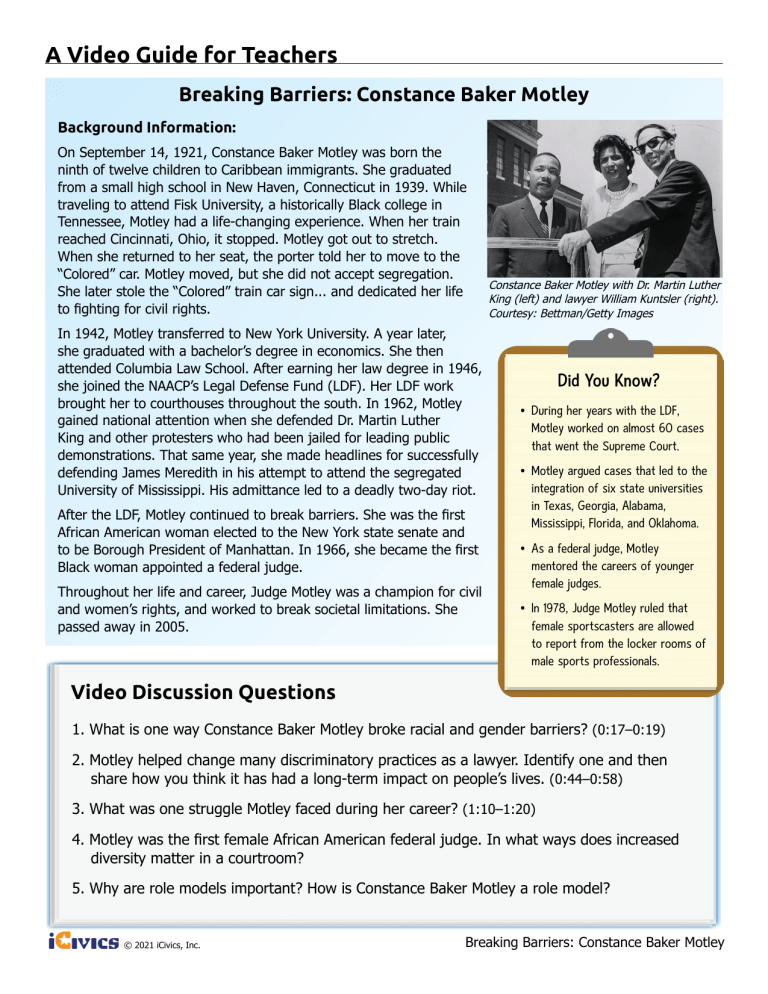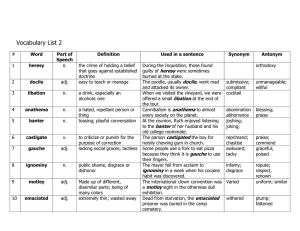
A Video Guide for Teachers Breaking Barriers: Constance Baker Motley Background Information: On September 14, 1921, Constance Baker Motley was born the ninth of twelve children to Caribbean immigrants. She graduated from a small high school in New Haven, Connecticut in 1939. While traveling to attend Fisk University, a historically Black college in Tennessee, Motley had a life-changing experience. When her train reached Cincinnati, Ohio, it stopped. Motley got out to stretch. When she returned to her seat, the porter told her to move to the “Colored” car. Motley moved, but she did not accept segregation. She later stole the “Colored” train car sign... and dedicated her life to fighting for civil rights. In 1942, Motley transferred to New York University. A year later, she graduated with a bachelor’s degree in economics. She then attended Columbia Law School. After earning her law degree in 1946, she joined the NAACP’s Legal Defense Fund (LDF). Her LDF work brought her to courthouses throughout the south. In 1962, Motley gained national attention when she defended Dr. Martin Luther King and other protesters who had been jailed for leading public demonstrations. That same year, she made headlines for successfully defending James Meredith in his attempt to attend the segregated University of Mississippi. His admittance led to a deadly two-day riot. After the LDF, Motley continued to break barriers. She was the first African American woman elected to the New York state senate and to be Borough President of Manhattan. In 1966, she became the first Black woman appointed a federal judge. Throughout her life and career, Judge Motley was a champion for civil and women’s rights, and worked to break societal limitations. She passed away in 2005. Constance Baker Motley with Dr. Martin Luther King (left) and lawyer William Kuntsler (right). Courtesy: Bettman/Getty Images Did You Know? • During her years with the LDF, Motley worked on almost 60 cases that went the Supreme Court. • Motley argued cases that led to the integration of six state universities in Texas, Georgia, Alabama, Mississippi, Florida, and Oklahoma. • As a federal judge, Motley mentored the careers of younger female judges. • In 1978, Judge Motley ruled that female sportscasters are allowed to report from the locker rooms of male sports professionals. Video Discussion Questions 1. What is one way Constance Baker Motley broke racial and gender barriers? (0:17–0:19) 2. Motley helped change many discriminatory practices as a lawyer. Identify one and then share how you think it has had a long-term impact on people’s lives. (0:44–0:58) 3. What was one struggle Motley faced during her career? (1:10–1:20) 4. Motley was the first female African American federal judge. In what ways does increased diversity matter in a courtroom? 5. Why are role models important? How is Constance Baker Motley a role model? © 2021 iCivics, Inc. Breaking Barriers: Constance Baker Motley Timeline for Breaking Barriers: Constance Baker Motley Name: Directions: Read through the timeline and the “Consider the Context” questions to help place the video’s events in history. Boxed events are lawsuits Motley either worked on or argued in court. Plessy v. Ferguson finds segregation is constitutional 1896 The Great Depression The U.S. enters WWII 1929–1939 1941 1909 1918–1930s NAACP founded Harlem Renaissance 1940 NAACP’s Legal Defense Fund is founded Barbara Johns leads a school WWII ends walkout 1945 Brown v. Board of Education finds school segregation unconstitutional 1951 1948 Shelley v. Kraemer decides restrictive covenants (agreements that discriminate against home buyers based on race or religion) can’t be enforced 1954 1952 Autherine Lucy & Pollie Ann Myers sue the University of Alabama for revoking their admission for being Black 14-year-old Emmett Till is brutally murdered The Little Rock 9 are met with resistance when they try to integrate Central High School 1955 James Meredith becomes the first African American admitted to the University of Mississippi 1957 1956 Rosa Parks refuses to leave her seat and triggers the Montgomery bus boycott 1962 The Civil Rights Act is passed, ending segregation in the U.S. 1964 1960 1963 1965 Counter sit-ins in Greensboro, NC and Nashville, TN protest discrimination in restaurants Over 250,000 people attend the March on Washington where Dr. King gives his “I Have a Dream Speech” The Voting Rights Act is passed, removing discriminatory barriers to voting Consider the Context. Use the timeline to answer the questions before or after watching the video. 1. Constance Baker Motley joined the Legal Defense Fund as a lawyer in 1946. How many years after it was founded did she join? Want to Learn More? Check out these resources. 2. How many years after Rosa Parks and the Montgomery bus boycott was the Civil Rights Act passed? Biography and Quotes http://bit.ly/3uTwaAU 3. How long after Lucy and Myers sued to attend the University of Alabama was James Meredith admitted to the University of Mississippi? Biography and Interview http://www.visionaryproject.org/ motleyconstancebaker/ 4. How long was it from Plessy v. Ferguson to the Civil Rights Act? What does the length of time tell you about the struggle for civil rights in America? 5. Which historic events may have influenced the fight for civil rights? How or why do you think they influenced them? © 2021 iCivics, Inc. Filmed interview http://repository.wustl.edu/concern/ videos/c821gm461 Activity



